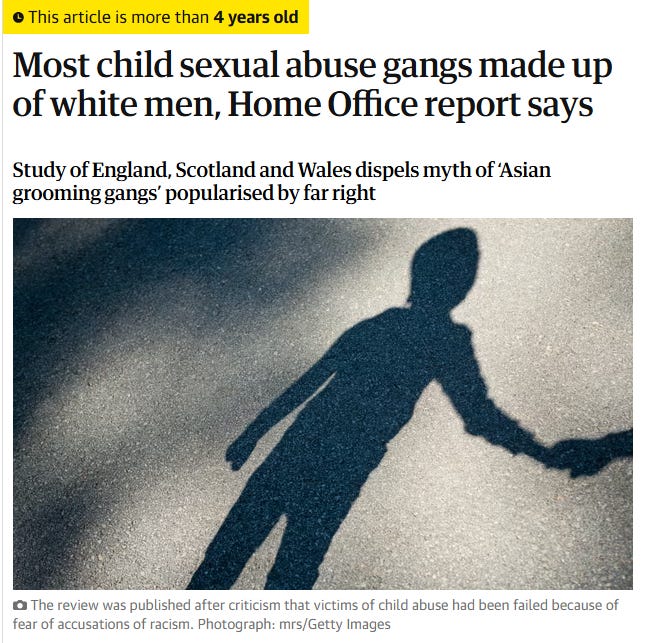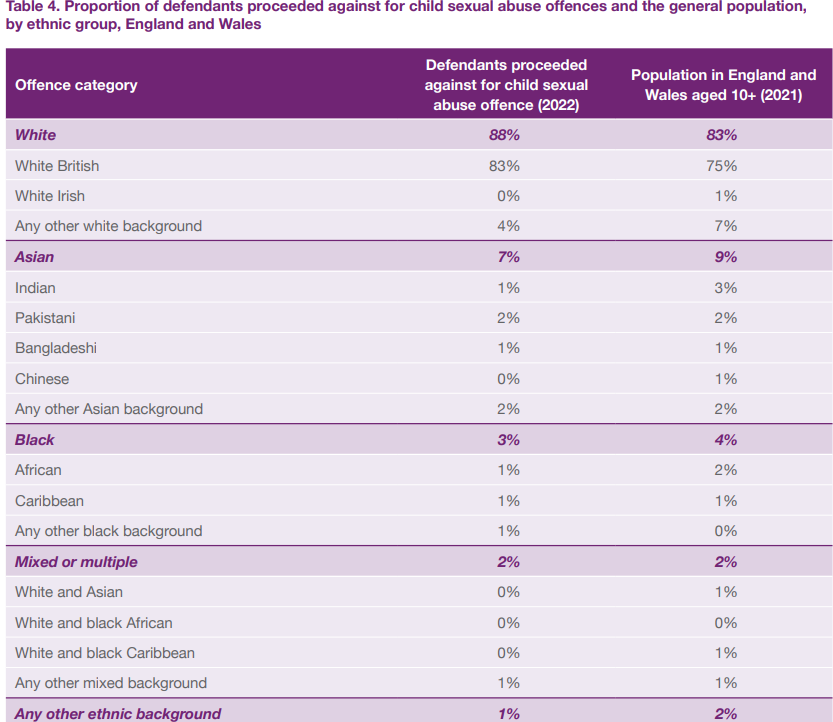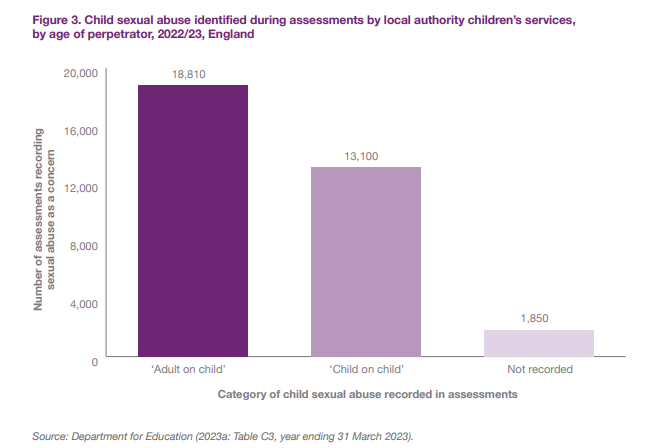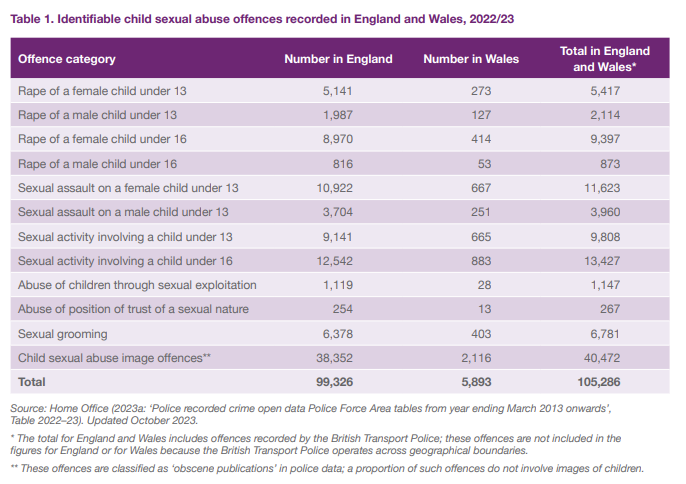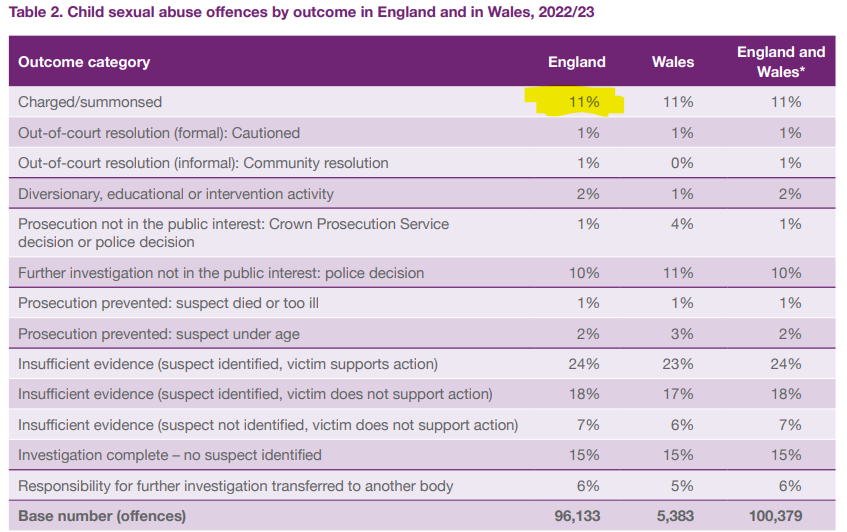Debunking the 'most child rape gang members are white' myth
A common refrain online is that most child rape gang members are white and that the focus on Pakistanis is unfounded. This article is intended to address the key sources used to support this argument.
Summary
Below are the two key sources for the case that focusing on Pakistanis is unfair.
2020 Home office report used for a Guardian article claiming most grooming gangs are made up of white men.
CSA center figures (typically a purple table graphic), purporting to show that 87% of child sex offenders are white.
Both will be examined in turn, below.
2020 Home office report
In 2020 the Home Office released a report which elements of the media used to run articles exposing the ‘Asian grooming gang myth.’
Then report itself was obviously dishonest in it’s conclusions and didn’t match the data it examined, but this wasn’t going to deter the Guardian from publishing a piece that doubled down on intentionally misrepresenting the data, which was then used as the basis for inaccurate reporting in other outlets.
The Home Office report, (which referenced old studies from 2011-2013) actually showed that Asians were massively over-represented among child sexual abuse suspects and offenders.
One found that Asians were 75% of those involved in group child sexual exploitation. Assuming almost all Asian suspects are Pakistani, which is a near certainty, and putting them about 2% of the population, we can infer from it’s findings that Pakistanis are at least 37 times over-represented.
Another study that used definitions too broad for it’s purpose found Asians were 28% of perpetrators (despite Pakistanis being at most, 2% of the population) of those involved, while whites were 30% (despite being about 90% of the population during this period) This would make Pakistani Muslims around 42 times more likely to be involved in CSA than white males.
Despite this, the headline for the home office report was that white males were mostly responsible for CSA. A dishonest conclusion designed to muddy the waters.
Several of the studies it referenced found that Asian men were massively over-represented by factors in the region of 15 times to 40 times relative to their share of the population. While whites were vastly under-represented.
There are serious questions about the quality of data in these studies. The report includes caveats about how, at the time the data was collected, group based child sexual exploitation was not yet understood.
However, it should be noted that this data relates to a time period at least ten years ago when many agencies were less familiar with CSE. This work also did not distinguish between groups and gangs.
Even with old data, and studies that were conducted before Asian rape gangs became a widely known phenomenon, the data showed vast Asian over-representation and massive white under-representation.
The Home Office report’s conclusion is contradicted by the data it cited and does not show that group child sexual abuse offenders are more likely to be white. Instead, it shows vast over-representation of some ethnic minority groups.
CSA-Center figures
Online, figures showing ethnicity of sex offenders drawn from a report by the CSA-centre, suggesting white males are 87% of child sex offenders has been used to make the case that child rape gangs are a white issue. We’ll look at the veracity of that conclusion below.
Below is the table being used to suggest Pakistanis are not over-represented.
These figures bear no relation to the issue of group child sexual exploitation and are largely superfluous to the debate.
Almost half the cases - 40,000 out of 105,000 - referenced involve allegations of viewing images of children online. A totally incomparable crime to networks of men raping children in the community.
A large percentage of the abuse included is ‘child on child’ offences. Essentially sexting and unwanted images sent between teenagers.
The report acknowledges difficulties in identifying sexual abuse among non-white communities. Suggesting the ethnic breakdown is representative of many offences going unreported.
Most of the cases are allegations. Only 11% of the alleged offences resulted in a charge.
Here is the passage where the report acknowledges difficulties in identifying sexual abuse in minority communities and acknowledges that white defendants are more likely to have been prosecuted for viewing images online as opposed to in-person sex offences.
This overrepresentation is likely to be related to the overall under-identification of child sexual abuse in minority ethnic communities. The conviction ratio ranged from 62% for Black defendants to 83% for White defendants. This is likely to be related to the offences for which people from different ethnic backgrounds were prosecuted: image offences, which were more likely to be the reason for White defendants to be prosecuted, were more likely than most other child sexual abuse offences to result in a conviction (see Table 3 above).
Below we see that many of the alleged offences identified related to child-on-child incidents.
Here we see that a large proportion (bottom line) represent viewing images online.
The figures below show that a lot of these reported offences have never been proven, or even judged worthy of investigation.,
In short, while concerning, the figures are not relevant to the issue of child rape gangs or even in-person sexual abuse at all. While both are crimes, no reasonable person would equate individuals viewing images online or teenagers sending images, to men preying on children in the community.
Conclusion
As discussed above, neither of these sources count against the evidence that Pakistanis are massively over-represented among group child sex offenders.
What they do show, is that those unwilling to accept the apparent ethnic nature of child rape networks in the United Kingdom are resorting to dishonest arguments.


